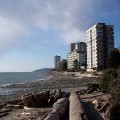You have to love a community that routinely serves draft beer in a pie bakery, cappuccino by the library's fireplace and pancakes in the Hollyburn Funeral Home's parking lot every June for the "Community Days Pancake Breakfast" They offer flapjacks to die for. Yet West Van, as locals call their village-minded corridor community that stretches along 28 kilometres of shoreline and up the southern slopes of the 100-million-year-old Coast Mountains, is missed most by tourists, who veer off into the Upper Levels Highway bound for Whistler or the Horseshoe Bay ferry terminal.
This is ironic. For although the Spanish explorer Jose Maria Narvaez and Captain George Vancouver also sailed right by in 1791 and 1792, West Vancouver really began as a popular summer holiday destination.
From the 1880s to the 1900s men and women canoed and eventually ferried across from Vancouver to picnic or camp in the fresh air upwind from what was literally "the Big Smoke" in those early day land-clearing and logging days. Every May to September a "tent city" sprang up along the shore from present-day Ambleside village to 23rd Street. By 1886 smart speculators had already bought up most of future West Vancouver.
James Blake preempted the first 65 hectares in 1872. A succession of firsts quickly followed. In 1873 the first white resident, Navvy Jack Thomas, a Welsh deserter from the Royal Navy, moved in. His house still stands in Ambleside. It is the oldest continuously inhabited residence in the Lower Mainland. In 1874 the first lighthouse was built at Point Atkinson.
By 1912 the place was humming, thanks to a regular ferry service that started in 1909, triggering a small real estate boom and relieving many families from the grim row across the treacherous tides of First Narrows to attend church in Vancouver. Waterfront lots in what was then called "West Capilano" went for $4,500; others for as little as $450. The District of West Vancouver was incorporated on March 15, 1912. From that seaside hamlet with a 1912 summer population of around 1,500, West Vancouver has grown to a municipality of nearly 42,000. A curious mix of old summer cottages, modest homes and multimillion-dollar waterfront estates, West Vancouver has no industry and no tourist attractions beyond the Park Royal Hotel and those that drew the first tourists: beaches, forests, mountain trails and ski slopes.
West Vancouver's largest source of revenue is property taxes and its biggest business is the municipality itself. West Van has its own police force and its own beloved "Blue Bus" system, as of February, 1996, the first transit system in Canada to be totally wheelchair accessible. With 27 per cent of the population over 60 (a 54 per cent increase in the past 10 years), this is good thinking.
West Vancouverites can also lay claim to reading more library books and earning more per capita than any other Canadians. They spend a chunk of it in Canada's first shopping mall, Park Royal, built in 1950 on lands leased from Squamish Indian Reserve No. 5.
The Vancouver Sun's award-winning editorial cartoonist Len Norris delighted in spoofing West Van's slope-side living. A resident himself, Norris drew genteel West Vancouverites (who conveniently peopled such real places as Tiddley Cove) gardening with one leg shorter than the other or grumbling about the Pacific Great Eastern Railway (now BC Rail) the initials PGE corrupted to mean "Past God's Endurance." Long before the PGE first connected North and West Van on New Year's Day, 1914, the earliest known settlement was a Coast Salish village at Sandy Cove. Europeans settled in their own string of small, self-contained west-to-east communities. Ambleside commemorates its "father of West Vancouver" in John Lawson Park. Dundarave was named for the Scottish home of R.E. Macnaghten (and the streets named for British prime ministers).
Caulfeild owes its bucolic setting and spelling to Francis William Caulfeild, an English gentleman and scholar who laid out the village "according to the contours of nature," including the paths of wild animals and cows. Now only a street, Bellevue was once a subdivision adjoining Dundarave. Dubbed "Vancouver's premier suburb," Bellevue's ads promised "A lot in Bellevue is a joy forever; two lots is rapture!" Further west, Colonel Albert Whyte pressed for the 1914 spelling change from White Cliff City to Whytecliff.

